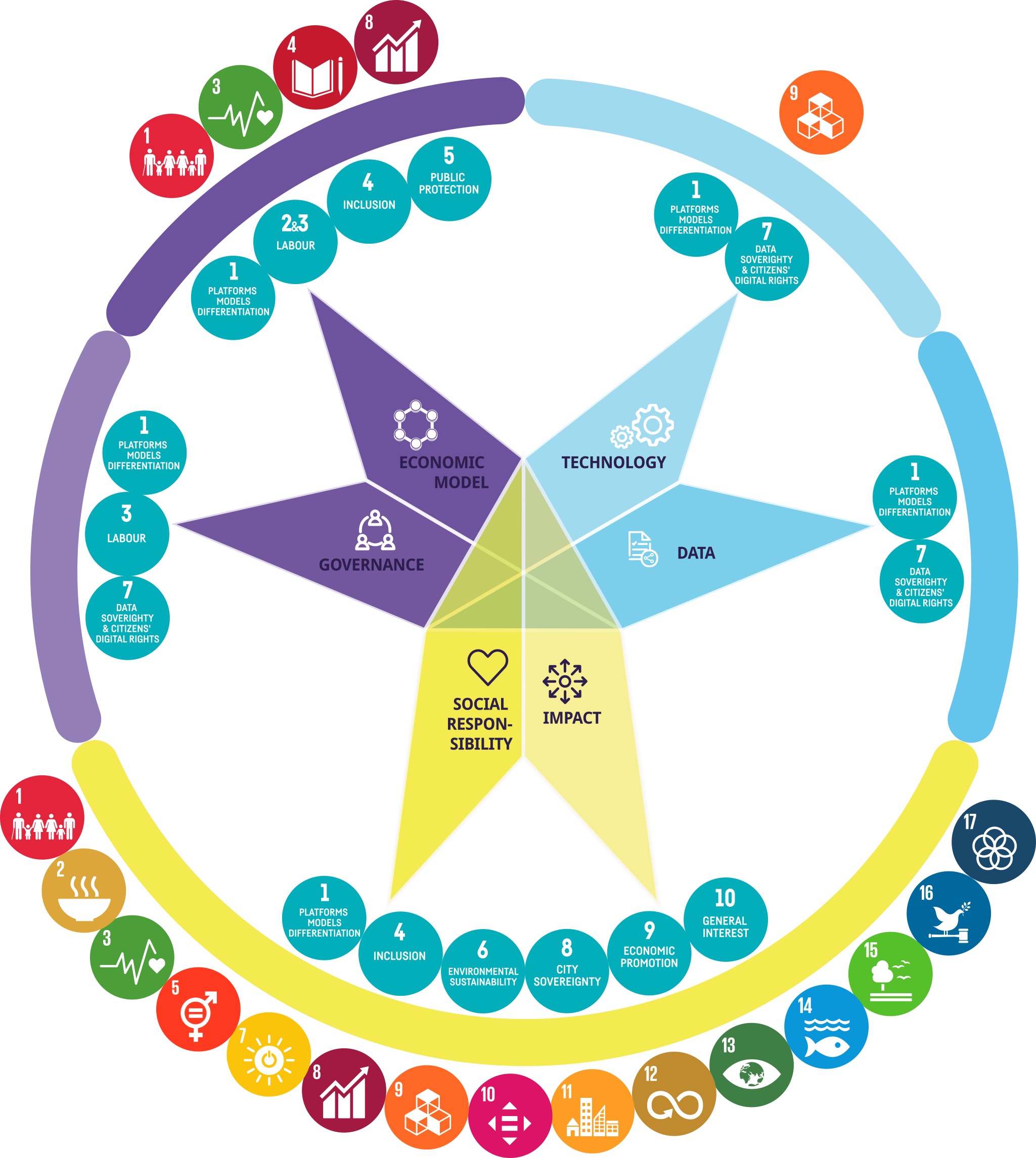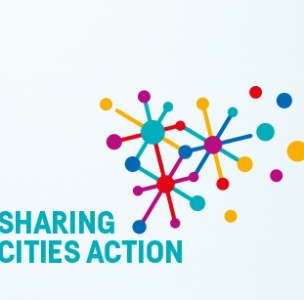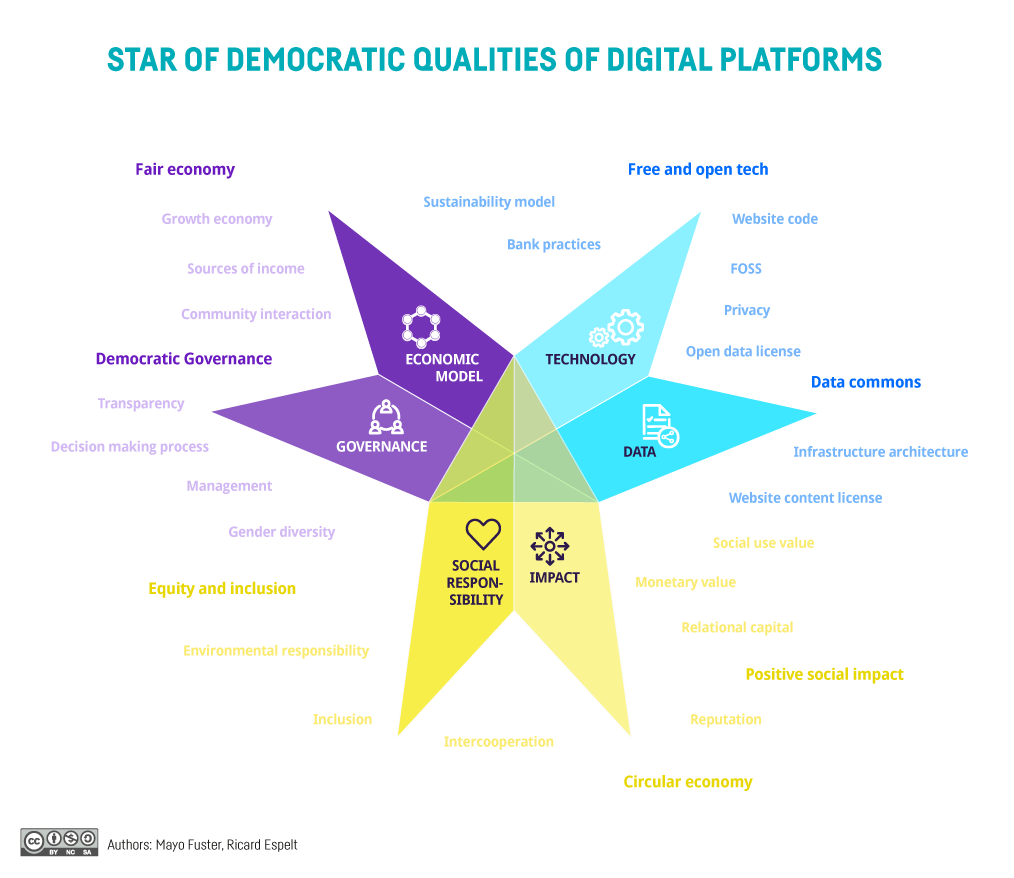What differentiates one digital platform from another? Even if their characteristics make them quite unique, we can categorize them following the Platform Economy Characterization Framework: the Sharing Star.
This is an analytical framework developed by Dimmons to be used for action-research.
The Star of Democratic Qualities of Digital Platforms with the principles of the Declaration of Sharing Cities and the Sustainable Development Goals incorporated.
1. Why to use this framework
Despite Platform Economy is growing rapidly and exponentially, creating great interest, and has become a top priority for governments around the globe suffers from three main challenges:
- Regulatory vacuum. Although Platform Economy has a tremendous potential and opportunity for public innovation that is not being exploited because of unsystematized policy reactions and uncertainty towards which policies may be more beneficial.
- Lacks of sustainability integration. Nevertheless Platform Economy has considered technological and economic sustainability, it has not integrated to other sustainability relevant questions, such as environmental impact, gender and inclusion, or legal implications, lacking a proper multidisciplinary perspective.
- Unclassification. There is a confusion about the platforms which present themselves as collaborative while actually, they are not; and similar uncertainties and ambiguities associated with diverse models. Indeed, there is a lack of a classification system that helps to establish the difference between the different models.
For this reason, the «Platform Economy Characterization Framework» (Fuster et al., 2017), which presents the democratic qualities of digital platforms, is a useful tool to review holistically the characterization of each digital platform.
- Why to use this framework
- A new approach: The Sharing Star and the UN’s Sustainable Development Goals
- What is the Platform Economy Characterization Framework
- How to use it
- Where the Platform Economy Characterization Framework has been used
2. A new approach: The Sharing Star and the UN Sustainable Development Goals

The Sharing Star’s new approach, developed on the occasion of the Sharing Cities Action Encounter 2019, tries to differentiate platforms depending on their democratic and collaborative attributes in line with the 2030 United Nations Sustainable Development Goals.
Firstly, this new approach helps to tackle the challenges raised by the platforms in cities from over the world. It can entail and contribute to achieving the objectives of the Declaration of Sharing Cities principles (at the city level) and the UN Sustainable Development Goals (at the global level). And secondly, the tool exposes the lack of digital perspective of the Sustainable Development Goals, in comparison to the Star of Democratic Qualities. The Sharing Star sheds light on the fact that the UN Sustainable Development Goals don’t pay sufficient attention to the critical role of the digital sphere in shaping contemporary development.
- Why to use this framework
- A new approach: The Sharing Star and the UN’s Sustainable Development Goals
- What is the Platform Economy Characterization Framework
- How to use it
- Where the Platform Economy Characterization Framework has been used
3. What is the Platform Economy Characterization Framework
The Platform Economy Characterization Framework is an analytical tool that helps to characterize the platforms, differentiate models by visualizing the democratic qualities of PE initiatives and provide insights of the sustainability implications of their design and performance from several perspectives. This pro-democratic balance considers the dimensions of governance, economic strategy, technology and data policies, and impacts and social responsibility towards the externalities of the platforms.
Governance
Regarding platform governance, we have considered several dimensions of governance and the extent to which they adopted an open modality. In that sense, we evaluate governance among value creators at the platform interaction level (matching platform functionalities with the grade that users can participate) and the governance regarding platform provision (considering legal constitution, policies of participation and transparency):
- The openness of the management of contributors. We have considered: 1.1) the ways users can contribute to the platform content, if it is possible to create new ways of generating content, and whether it is possible to create content or (only) offer/demand/rate products or services; 1.2) the policy of platform participation: whether participation is open without filters, moderated before publication, or moderated after publication; 1.3) the possibility of user interaction: if users can communicate among themselves or create groups; and 1.4) if the platform considers different types of user accounts or a single type open to any user.
- The openness of the election of administrators. We considered: if the users can self-appoint themselves as administrators; if administrators gain privileges automatically through participation; and if administrators are elected from among the general community, by other administrators, or by the infrastructure provided.
- Decision-making with regard to community interactions, including whether or not there are formal or informal systems for community decision-making, and if the definitions of the formal rules and platform policies are open to user contributions.
- The type of legal entity and the options for community members to engage with each type of legal entity. We have considered: public administration, university, foundation, association, cooperative, business company, or without legal format.
- Finally, governance linked to economic management. We considered: 5.1) economic transparency (if the economic balance is accessible to the community or if it is provided publicly); and 5.2) openness in deciding the destination of project benefits (if only project owners or the whole community have channels to be informed of and manage the benefits).
Economic model
At the time of studying the different PE models, we consider the link between the orientation of the economic benefits and the social impact of the activity, the economic sustainability of the project and the financing models. Thus, we evaluate economic orientation taking into account:
- the type of legal entity and the potential economic return that is established with the community in relation to its financing model (from more to less community): public administration, university, foundation, association, cooperative, commercial company or without legal format;
- the distribution of the economic benefits: reinvested in the project, divided between the proprietors or other options;
- the growth model: organic, that is to say, escalating economically without impacting on the governance model; reproductive, that is to say, replicating the model or speculative, that is to say, with the will to achieve maximum growth and then sell the project;
- the commercial character of the platform, considering whether monetary exchanges between users are: never, almost never, sometimes, often or almost always, and 1.5) the use or not of banking services ethics.
- Regarding sustainability, we evaluate whether the economic balance of the initiative is positive or not.
- Regarding the platform’s financing models, we study the type of resources used: private capital, public financing, non-monetary internal donations, external non-monetary donations, family savings, organization of events, research programs (H2020), commercialization of the brand, microfinance, prizes, by-products or derivatives, free resources, training programs, premium services, quotas, alternative currencies, bank credit, merchandising, advertising, monetary donations and commercialization of data.
Technology
Technological practices and policies openness refers to the adoption of software and technological architecture that favor freedom and openness.
We have adopted as indicator the type of license of the software code the platform uses. We have categorized the licenses depending on their degree of favorability to openness, or “freedom”. In this case we have prioritized the robust licenses (copyleft), such as GPL and LGPL, that allow freedom to be maintained throughout the entire chain of users, from its author to the end user, for which they make use of copyleft, forcing derivative work to be maintained with the same copyright regime as the original. Then, in degree of openness, we place the permissive software licenses, such as MIT and BSD, that make the distribution of the work more flexible, either as free or private. Finally, we locate all rights reserved or contents without license.
Regarding technological architecture, two indicators have been adopted. First the type of technological infrastructure on the platform. We categorized these, from more open to less, considering, at the same time, reproducibility (the availability of source code as FOSS) and distribution (which would range from p2p to federated to centralized). As: 1) Peer-to-peer (e.g., BitTorrent); 2) Centralized reproducible FLOSS, but not federated (e.g., Media wiki); 3) Federated (e.g., Kune); 4) Centralized in one entrance point (e.g., Wikia); and 5) Centralized but not reproducible because one node is exclusively provided by the platform owner and proprietary (e.g., Facebook). The other indicator considered is the use of blockchain (Yes/No) with the objective to decentralize the platform’s technological architecture and open up the community participation.
Data
Regarding knowledge platform policies, we have adopted two types of elements: content and data. The content element refers to the type of user-generated content license. The license used and their categorization from more open/free to less were: 1) Public Domain; 2) CC0, 3a) CC BY , 3b) CC BY-SA, 4a) CC BY-NC 4b) CC BY-ND, 5) CC BY-NC-SA, 6) CC BY-NC-ND, 7) All rights reserved or No license. In this case, we have balanced the possibility to share only by author recognition (CC BY) and the possibility to keep the same license attributions (CC BY-SA). In the same sense, we have equated the possibility to create author recognition non-commercial derivatives contents (CC BY-SA) and author recognition with no derivatives (CC BY-ND) but potential commerciable contents.
Regarding data policies, the indicator adopted is the ability to access data generated by users, taking into consideration their agreement. The options considered were (from more open to less): 1) API without restrictions; 2) Full data export (data dump); 3) Freely downloadable as a whole; 4) API with some restrictions; 5) Freely downloadable in part; and 6) Not possible to export, copy, or access any API.
Social responsibility and impact
These dimensions are related to any source of awareness and responsibility regarding the externalities and negative impact such as social exclusion, and social inequalities, regarding the equal access of people with all kinds of income and baggage in an equitable and impartial way (without discrimination) to gain access to the platform; the inclusion of gender, compliance with health standards and safety standards that protect the public; and the environmental impact, the impact in the policy arena, and the preservation of the right to the city of its inhabitants and the common good of the city; the protection of the general interest, public space, and basic human rights, such as access to housing.
On the basis of the commons balance of PE, sharing-oriented PE can be defined as a tendency, a set of qualities, and a modality of sharing economy —regarding both the design and the performance of the process— characterized by a commons approach regarding the dimensions of governance, economic strategy, technological base, knowledge policies, and social responsibility of the externalizations impacts of the platforms. In this regard, sharing-oriented platform economy is characterized by (1) favouring P2P relations—in contrast to the traditionally hierarchical command and contractual relationships detach from sociability, and merely mercantile exchange—and the involvement of the community of peers generating in the governance of the platform; (2) it is based on value distribution and governance among the community of peers, and the profitability is not its main driving force; (3) it’s developed over privacy-aware public infrastructure, and results in the (generally) open access provision of commons resources that favor access, reproducibility and derivativeness; and finally, (4) the responsibility with the externalities generated by the process.
- Why to use this framework
- A new approach: The Sharing Star and the UN’s Sustainable Development Goals
- What is the Platform Economy Characterization Framework
- How to use it
- Where the Platform Economy Characterization Framework has been used
4. How to use it
Codebook
Here the first version of Platform Economy Characterization Framework codebook.
Toolkit
Departing from the Platform Economy characterization framework two tools have been developed to facilitate the creation of a digital platform of collaborative economics. On the one hand, the Platform Economy traffic light is a tool designed so that people who use it ask questions about the different dimensions when it comes to projecting or reviewing a digital platform. On the other hand, the tool of the Platform Economy conversation is formulated as a space where, through the game, the people who use it can discover and discuss the different elements to consider in the creation of a platform.

- Why to use this framework
- A new approach: The Sharing Star and the UN’s Sustainable Development Goals
- What is the Platform Economy Characterization Framework
- How to use it
- Where the Platform Economy Characterization Framework has been used
5. Where the Platform Economy Characterization Framework has been used
The Platform Economy characterization framework has been used in different perspectives.
- Data from web collection about 100 platforms of collaborative economy operating in Barcelona.
Academia
Fuster Morell, M. i Espelt, R. (2018). How much are digital platforms based on open collaboration? An analysis of technological and knowledge practices and their implications for the platform governance of a sample of 100 cases of collaborative platforms in Barcelona. OpenSym 2018, París, 22 i 24 d’agost de 2018. ACM Digital Library.
Espelt, R. i Fuster Morell, M. (2018). Quina relació hi ha entre el model econòmic d’una plataforma d’Economia col·laborativa i la seva governança?. 3r Congrés d’Economia i Empresa de Catalunya: Cap a un model eficient i equitatiu. Barcelona, 17 de maig de 2018.
Fuster Morell, M.; Espelt, R. (2018). A Framework for Assessing Democratic Qualities in Collaborative Economy Platforms: Analysis of 10 Cases in Barcelona. Urban Sci (ISSN 2413-8851). 2018, 2, 61.
Fuster, M. i Espelt, R. (2017). Platform Cooperativism Holistic Characterization and Delimitation: 10 Cases of Barcelona Ecosystem. SASE 2017 Mini-conference: Re-embedding the Social: Cooperatives, Political Consumerism and Alternative Lifestyles. Lyon , 29 de juliol de 2017.
Research projects
Fuster, M; Carballa, B; Smorto, G; Espelt, R; Imperatore, P; Rebordosa, M; Rocas, M; Rodríguez, N; Senabre, E. i Ciurcina, M. (2017). Analytical framework of the democratic and procommons qualities of collaborative economy organizations. Decode project.
Public policies framework
During the process of participants selection in the Sharing Cities Summit 2018.


